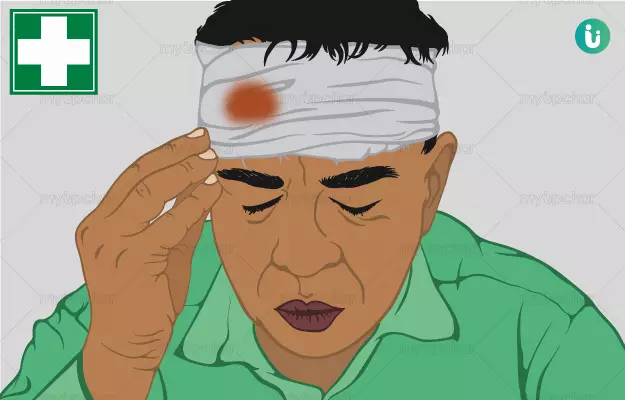The strong structure of the human skull usually means that most head injuries are not serious. You may find a bump or bruise on the head, which may resolve on its own with time. However, a severe blow to the head or repeated head injuries can lead to damage in the brain.
The brain is a jelly-like organ which is protected by the hard, bony skull. The brain floats in a clear liquid called cerebrospinal fluid (CSF) which acts as a shock absorber and protects the brain from minor injuries. Though a small knock to the head or face can be absorbed by the CSF, a hard blow can crack the skull open, smashing the brain in the process.
Major injuries like these lead to the destruction of blood vessels, causing the brain to bruise and swell. When the brain swells up within the skull, the pressure inside the brain (intracranial pressure) rises, leading to permanent damage to the brain.
The knowledge of basic first aids can help in saving the lives of people suffering from minor and major head traumas.
- Types of head injury
- Signs and symptoms of head injury
- Signs of a minor head injury
- Signs of a major head injury
- First aid for a minor head injury
- First aid for a major head injury
Types of head injury
Head traumas can present in two ways:
- Open trauma to the head: Bleeding wounds could be seen on the face and head.
- Closed trauma to the head: There is no visible sign of the injury that could be seen on the outer surface of the head.
Signs and symptoms of head injury
There are certain signs that can be noticed in a person with sudden head trauma.
Signs of a major head injury
The signs of a major head injury are:
- Deep wound due to severe blow to the head
- Drowsiness that increases with time
- Persistent thumping and a pounding headache
- Unequal size of the pupil
- Blurred or double vision
- Constant state of confusion
- Loss of balance and difficulty in walking
- Recurring episodes of vomiting
- Slurred speech
- Deteriorating levels of response
- Blackish blue discolouration below the eyes or behind the ears
- Weakness in the fingers or down one side of the body
- Blood or blood-stained watery fluid coming from the ear or nose
- Seizures
- Unconscious or cessation of breathing
First aid for a minor head injury
A person with a minor head trauma might get dizzy or feel sick for a small period of time. You may find a small wound or a bump on the scalp. These are the steps you need to follow in order to provide first aid to a person with minor trauma to the head:
- If the person is conscious, make the person sit down comfortably and then apply a cold ice pack onto the affected area. This will help to reduce swelling and stop the bleeding (if any).
- Pack any visible wound using sterile gauze. Do not apply too much pressure.
- While still applying the compression, assess the levels of responsiveness in the person using the AVPU scale. AVPU scale is used to grade a patient’s gross level of consciousness, responsiveness and mental status.
- Alert: Ask the person, if they are aware of their situation and their surroundings. Ask the person to follow commands like opening their eyes, following the finger movement.
- Verbally Responsive: If the person is not opening their eyes, ask them questions and check for their responsiveness.
- Painfully Responsive: If the person is not responding to verbal command, apply a painful stimulus (like pinch the person) to check the person’s responsiveness to pain. The person may respond by moving, moaning, or crying out directly in response to the stimuli.
- Unresponsive: The person does not open their eyes and is neither responsive to verbal command nor to painful stimuli.
- If the person is responsive and is getting better with time, no medical assistance is required.
- If the person becomes unresponsive or has had previous brain surgeries or is on blood thinners, call for immediate medical help.
First aid for a major head injury
A person with a major head injury might have severe drowsiness and would not be able to walk or talk properly. They might be unresponsive and might require immediate medical care. Follow these steps in order to provide first aid to a person suffering from a major head injury:
- If you see the signs of major head trauma, immediately call for medical help.
- Do not move the person until necessarily required because its most likely that if the head is injured, the spine would have injured too. Inappropriate movement of the neck can cause more harm.
- If it is an open wound, apply sterile gauze onto the wound. Do not apply high pressure.
- If you see fluids leaking off the nose and ears, apply a sterile gauze to cover the area. Do not stuff the nose and ears with the gauze.
- Cover the person with a blanket to maintain the body temperature.
- If the person stops breathing before the medical help arrives, you might have to give Cardiopulmonary resuscitation (CPR) to them. CPR is an emergency procedure performed on an unconscious person which involves delivering manual respirations followed by chest compressions to ensure that oxygen reaches to the organs.
Find Emergency medicine specialist in cities
- Emergency medicine specialist in Gurgaon
- Emergency medicine specialist in Delhi
- Emergency medicine specialist in Kurung Kumey
- Emergency medicine specialist in Una
- Emergency medicine specialist in South 24 Parganas
- Emergency medicine specialist in Jammu
- Emergency medicine specialist in Jaipur
- Emergency medicine specialist in Washim
- Emergency medicine specialist in Dhar
- Emergency medicine specialist in Thoubal
References
- St John Ambulance [Internet]. Order of Saint John. London. UK; Head injuries in babies and children
- St John Ambulance [Internet]. Order of Saint John. London. UK; Head injuries in adults
- St John New Zealand [Internet]. Ellerslie. Auckland. New Zealand; Head Injuries
- The British Red Cross Society [Internet]. UK; Learn first aid for someone who has a head injury
- Romanelli D, Farrell MW. AVPU (Alert, Voice, Pain, Unresponsive) [Updated 2019 Feb 10]. In: StatPearls [Internet]. Treasure Island (FL): StatPearls Publishing; 2019 Jan-










